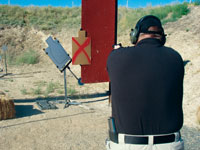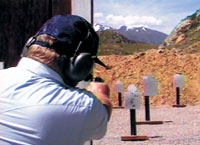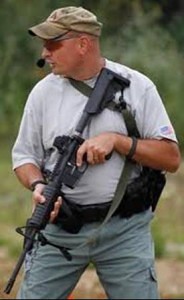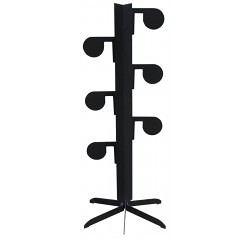Month: September 2011
Range Project Spotlight: Winston-Salem, NC
Designing and building ranges for many years with Action Target, Mike Stilwell has been actively involved in countless shooting range projects, including his own successful 16 lane commercial range, Rangemasters of Utah. Having 13 years experience of owning and operating an Action Target range is what made Stilwell an excellent person to help design and build a range for the Winston-Salem Police Department (WSPD).
 When Stilwell first became associated with the WSPD, they presented him with hand-drawn sketches, lots of notes, and passion to build a world-class indoor training facility. WSPD required more than the typical 25 yard police range. They wanted to build one of the longest indoor ranges found in their geographic region.
When Stilwell first became associated with the WSPD, they presented him with hand-drawn sketches, lots of notes, and passion to build a world-class indoor training facility. WSPD required more than the typical 25 yard police range. They wanted to build one of the longest indoor ranges found in their geographic region.
Stilwell first met the team from WSPD four years prior to this range build. He met Sgt. Bricker and Sgt. Hinson at Action Target’s Range Development Seminar held each year at Camp Butner, NC. Due to the lengthy process of getting their range started, Sgt’s Bricker and Hinson were no longer on the police force when the range was completed; however, the personnel change did not stop the project from moving forward. Stilwell is currently finishing the ranges with Sgt. Nelson and Lt. Watson to make the dream of building a world class training facility a reality.
 The Winston Salem Training Academy is an indoor shooting range project currently being installed. It has two ranges, with one being 50 yards and the other 100 yards in length. There are tactical ranges with multiple Total Containment Traps–Version 4 (TCT4) bullet traps, with an open mouth throat for cross lane and tactical shooting. The TCT4’s have a screw conveyor lead collection system, inverted dual track runners, and 180 degree turning D-TaPS Target Systems. Both ranges are rifle rated and have 3/8” AR500 steel in the trap and on the baffles. The walls and ceilings are treated with PEPP acoustical material to ensure generous sound dampening, creating a comfortable area to practice shooting. The Winston Salem Training Academy is designed by the world-class A&E firm of Clark Nexsen with Dan Walker and Bobby Cummings taking an active role. The GC awarded the project was Branch & Associates from Roanoke, VA with Jerry DeVault as the Project Manager (PM). Clark Nexsen and Branch also designed and built the ranges at the Virginia Military Institute (VMI), which ATI was fortunate to be a part of.
The Winston Salem Training Academy is an indoor shooting range project currently being installed. It has two ranges, with one being 50 yards and the other 100 yards in length. There are tactical ranges with multiple Total Containment Traps–Version 4 (TCT4) bullet traps, with an open mouth throat for cross lane and tactical shooting. The TCT4’s have a screw conveyor lead collection system, inverted dual track runners, and 180 degree turning D-TaPS Target Systems. Both ranges are rifle rated and have 3/8” AR500 steel in the trap and on the baffles. The walls and ceilings are treated with PEPP acoustical material to ensure generous sound dampening, creating a comfortable area to practice shooting. The Winston Salem Training Academy is designed by the world-class A&E firm of Clark Nexsen with Dan Walker and Bobby Cummings taking an active role. The GC awarded the project was Branch & Associates from Roanoke, VA with Jerry DeVault as the Project Manager (PM). Clark Nexsen and Branch also designed and built the ranges at the Virginia Military Institute (VMI), which ATI was fortunate to be a part of.
 Action Target and Stilwell consider it an honor to be a vital part of this world-class facility and to work with all of the individuals who made this project happen. Special thanks goes out to the Firearm Instructors of Winston Salem, both past and present, Bryan Dahlberg—Project Manager for Action Target—and Jerry DeVault—Project Manager for Branch & Associates—for their long, tireless hours.
Action Target and Stilwell consider it an honor to be a vital part of this world-class facility and to work with all of the individuals who made this project happen. Special thanks goes out to the Firearm Instructors of Winston Salem, both past and present, Bryan Dahlberg—Project Manager for Action Target—and Jerry DeVault—Project Manager for Branch & Associates—for their long, tireless hours.
If you’re ever near the WSPD, give them a call to set up a date and time to take a tour of their new facility. If you are considering an indoor or outdoor range project and are in the Mid-Atlantic States region, contact Mike Stilwell at mikes@actiontarget.com
Other recently completed projects include:
- South East Territory – Browns Ferry Police Department
- South West Territory – Orem Police Department
- South Central Territory – Midwest Police Department
- North Central Territory – Green Bay Police Department
- North East Territory – Montgomery Police Department
- North West Territory – Three Sites
- East Central Territory – Shooters Edge, LLC
Shooting Steel Targets (Part I)
*Note: This is the first of a three-part series entitled “Shooting Steel Targets.” Part Two and Part Three were published in October.
As the world’s leader for shooting range development, Action Target has a diverse line of products to meet the needs of all its customers. If there is ever a request for a target system not currently offered, we have a full team of Research & Development personnel to explore the creation of a new target solution. Many times, however, the training need can be met with some of the simplest targets.

Action Target has been hailed as the #1 steel shooting target manufacturer based on our unique designs, which have been developed and modified over 26 years. Our steel targets have been influenced, tested, designed, and used extensively by law enforcement, the military, and Special Forces groups around the world. These groups prefer our steel targets since they do not allow any exposed bolts or brackets on the shooting surfaces. This is a limitation to many designs, but the result is the safest possible steel target available.
When using any of our portable steel shooting targets, please remember these safety guidelines to ensure that your experience of shooting targets is a fun and safe one:
STEEL TARGET SAFETY RULES
1. Always obey the Firearms Safety Rules listed below
2. Always wear hearing protection and wrap-around shatter resistant eye protection
3. Always stand at least 10 yards from the target when using handgun calibers
4. Always stand at least 100 yards from the target when using shotgun slugs
5. Always stand at least 100 yards from the target when using rifle calibers like .223 and .308
6. Never use rifle calibers on handgun rated targets
7. Never use ammunition that exceeds 3,000 feet per second at the muzzle
8. Never use ammunition that travels below 750 feet per second
9. Never shoot BB’s, steel shot, or air gun pellets at steel targets
10. Never use more powerful ammunition than the target is rated for (green tip, armor piercing, etc.)
11. Never shoot on steel that is cratered, pitted, or damaged in any way
12. Hard ground surfaces under the target should be covered with plywood or boxed pea gravel
13. Targets should be placed with a 3-foot lateral and deep offset from the adjacent target
14. If shooting multiple targets, the angle of engagement should not exceed 20 degrees
15. Use only non-toxic paint on steel targets
16. Inspect all targets before use for damage, functionality, etc.
17. Shooters and observers must wear long pants (no shorts), long sleeve shirts, a cap or hat with a brim, and closed toed shoes
18. Instructors and observers should stand behind the shooter and observe all safety rules
19. If using frangible ammunition, it is the responsibility of the Rangemaster to test fire all frangible rounds to determine the following:
- That the projectile pulverizes completely on contact
- That the projectile does not damage the steel target at the distances you intend to shoot from
For more information about our steel targets or the importance of safety while shooting targets, visit our Portable Targets page on the Action Target website.
The Muzzle-Discipline Solution
By John Krupa III & John Farnam
At a recent Urban Rifle Course held at an outdoor range, a student with the muzzle of her AR (patrol rifle) elevated had a ND (negligent discharge), which put a single 5.56 x 45 bullet over the berm and off-property. The bullet in question subsequently impacted, at a high angle, a lake a half-mile downrange. No injury or property was damaged as a result, but several local fishermen reported the incident to the local sheriff’s office, and I heard about it shortly thereafter.
Berm heights vary widely from range to range. Most are 10 feet or higher. Even so, sending a bullet over the berm is still easily done, no matter the height. Some fancy ranges even have downrange, overhead “baffles” designed to keep bullets–inadvertently launched at a high angle–from leaving the range; however, even at these facilities, bullets occasionally seem to find a way off-property. Additional efforts to contain them invariably convert the “outdoor range” into an indoor range!
The better solution to this issue is muzzle-discipline.
“Muzzle-Down” is the by-word on all DTI (Defensive Training Institute) Ranges. All rifle, pistol, and shotgun handling is with the muzzle no higher than horizontal. Elevating muzzles past horizontal during administrative processes, and during reloading and stoppage-reduction, is commonly taught in some quarters, but it is wrong and dangerous!
In the incident described above, a rifle muzzle was inadvertently elevated during the loading process, as the student was relying on previous training. We corrected it, of course, but not before that single round departed range property.
When ND’s occur with the muzzle down and angled toward the berm, the bullet hits the ground between the shooter and the berm and can still subsequently jump over to the other side. However, these ricochets are typically low energy and far less dangerous than direct launches. “Muzzle-Up” is bad practice for other reasons too. Handling guns with the muzzle up is an invitation to a disarm, and rifle barrels angled upward will reliably betray an operator’s position and intentions, particularly when he/she is behind cover.
So, our students need to become accustomed to keeping all muzzles continually at a downward angle, coming up to horizontal only when aiming at a target. All administrative processes-loading, unloading, and performing a chamber-check can be (and must be) done with the operator facing in a relatively safe direction with the muzzle angled downward.
With escalating numbers of novice gun owners, preventing gun accidents is rapidly emerging as a critical priority. Gun-fear, trigger-locks, and the “empty-gun/never-ready” philosophy represent only a false and fraudulent myth. Genuine Operators, who carry and deal with loaded guns every day, need a legitimate and dependable gun-handling procedure that is adhered to without fail, and keeping muzzles down is an integral component.
About John Krupa III
John is a police officer with the Orland Hills Police Dept. and has over 20 years of experience in LE. He has previously served as a beat officer, rapid response officer, and firearms instructor with Chicago PD. He is a graduate firearms instructor from the Secret Service Academy, FBI, DEA, and FLETC. John is founder and president of Spartan Tactical Training Group, Director of Training for the DS Arms LE Training Division, and has previously presented at ASLET, GTOA, IALEFI, ILEETA, ISOA, LETC, MTOA, NTOA, and TTPOA training conferences. To learn more about John Krupa III or Spartan Tactical Training Group, click here.
About John Farnam
John has been a police officer since 1971, when he joined the City of Elroy Police Department as a patrolman. He is presently a fully commissioned deputy sheriff Training Officer for the Park County, Colorado Sheriff’s Office. John has written articles about defensive shooting and tactics in addition to several books. To learn more about John Farnam or Defensive Training Institute (DTI), click here.
* The views are the authors’ own and don’t necessarily represent those of Action Target, Inc.
2011 Law Enforcement Training Camp
For the past 20 years, Action Target has hosted one of the most comprehensive training camps for law enforcement in the United States. Law Enforcement Training Camp (LETC) consists of a week-long curriculum of your choice, including four 8-hour classes. Each course is taught by world-class firearm instructors.
 LETC 2011 began Monday, September 12th and goes through September 16th in Provo, Utah. LETC’s world-class instructors hail from the Safariland Shooting School, Hoffner’s Training Division, Team Spartan, GLOCK Training, Bill Rogers Shooting School, Sig Sauer Academy, and the Action Target Academy. Having high-caliber instruction coupled with a comprehensive curriculum in one single training event makes LETC an annual attraction for agencies from the US and abroad.
LETC 2011 began Monday, September 12th and goes through September 16th in Provo, Utah. LETC’s world-class instructors hail from the Safariland Shooting School, Hoffner’s Training Division, Team Spartan, GLOCK Training, Bill Rogers Shooting School, Sig Sauer Academy, and the Action Target Academy. Having high-caliber instruction coupled with a comprehensive curriculum in one single training event makes LETC an annual attraction for agencies from the US and abroad.
Make no mistake–this training is not an event for simply showing off your shooting skills. LETC offers the most trigger time and practical application possible as well as the exchange of ideas, concepts, tactics, and the best cop stories around.
Every year, LETC participants take what they have learned and incorporate it into their existing firearms training programs for academy and in-service personnel. Law enforcement agencies from the US, Canada, and around the world congregate at LETC each year, knowing that it would be impossible for any agency to bring together such a wide variety of advanced trainers, topics, and tactics on their own.
LETC provides students the opportunity to select a different course to attend each day. A few courses we offered this year include:
- High Performance Handgun
- Patrol Rifle/Carbine
- Ultimate Shotgun
- Rapid Deployment Patrol Rifle Operator
- Emergency Medical Response for Firearm Instructors
- Shoot, Move, & Communicate
- Glock Armorer
- Reactive Shooting on Steel for Speed & Accuracy
- Advanced Practical Handgun
- Success with Remedial Shooters
If you are looking for a full week of shooting with some of the best law enforcement firearm instructors in the US, secure your spot in next year’s Law Enforcement Training Camp today! Visit the Action Target Training Calendar in the Academy section of our website for more information and to take advantage of early registration savings.
AT Dueling Tree AR550 for only $425

During the entire month of September, we are offering our AT Dueling Tree AR550 ![]() (Heavy Duty) for only $425 as part of our Target of the Month program! This offer is available at the Action Target Store
(Heavy Duty) for only $425 as part of our Target of the Month program! This offer is available at the Action Target Store ![]() or by contacting the Territory Manager for your region.
or by contacting the Territory Manager for your region.
Enter the code FSAR550DT when placing your order in the online store for the discount. Only one code per order. There is NO LIMIT on the number of products ordered. Offer cannot be combined with other discounts or specials. Offer expires September 30, 2011.
Identifying and Pursuing Funding Opportunities
by Ian A. Reeves, AIA | Vice President | Architects Design
and
Jean Pierre LeBlanc | Research Coordinator | Group Research Coordinator – Center for Public Safety
*This article first appeared in the Spring 2011 issue of Florida Police Chief Magazine and has been republished with their consent.
Editor’s Note: It seems as if anything related to firearms is controversial. If you want to sell, carry, train with, or build a shooting range, you will always be confronted with some type of challenge. Therefore, it is vital that when key information becomes available to help navigate the complexities and minutia of firearms-related issues, it be passed on through multiple mediums to further educate us all. We know this information is important and our subscribers would appreciate it, which is why Action Target has chosen to republish this article in our own weekly newsletter, The Action Target Journal.
One of the primary factors in the consideration of any new Law Enforcement or Public Safety facility is the necessity to identify a funding source, or as is true in most cases, a variety of funding sources. In essence, it is important to not only qualify a project’s spatial needs, but to also provide meaningful information as to how a project can be funded.
Assistance, in this regard, can generally be provided by City/County staff, either a Budget or Finance Director, or by City/County Administration. The more you can assist them in this endeavor, the greater are your chances to see your prospective project move forward.
While Federal grant funding has traditionally been rare for local facilities, the events of September 11th, coupled with the current economic expansion, created an environment which resulted in funds becoming available in a wide variety of locations. Many cities and counties, in that respect, have initiated studies in order to have appropriate documentation assembled for Federal grants. Additionally, they have contacted their respective legislative delegation members in order “to make their case.” Clearly, time becomes of the essence, as when Federal Funds become available, they will go to those that are prepared and who are situated in a geographically and politically important location.
Current Department of Homeland Security (DHS) and Federal Emergency Management Agency (FEMA) philosophy is patterned along these lines: If your community feels the need to support the premise of public safety, then it should be willing to provide the basic necessities for that to occur.
These basic necessities include:
- Buildings to work from and house equipment
- Manpower; in the form of either paid employees or volunteers
- Vehicles/Specialized Equipment
While there are a multitude of potential funding sources, such as Development Impact Fees, General Obligation Bonds, Law Enforcement Trust Funds, Franchise Fees, and Federal Legislative Requests, this article focuses on Grants which can provide some funding for the development of new Law Enforcement/Public Safety Facilities. Below is an applicable outline, including links for more information. Several of these grant programs have closed for FY 2011, but are expected to be available for FY 2012. We suggest you begin planning now, as this process requires a strategic approach that takes time to develop.
1. State Homeland Security Program (SHSP)
Funding Agency: DHS, FEMA
Forecasted Deadline: Deadline has passed, but anticipate similar deadline of 4/2012
Total Estimated Funding Available in FY 2011: $890 million
Purpose: SHSP is a core assistance program contained within the overarching Homeland Security Grant Program (HSGP). SHSP provides funds to build capabilities at the state, local, tribal, and territorial levels and to implement the goals and objectives included in state homeland security strategies and initiatives in their State Preparedness Report (SPR). Activities implemented under SHSP must support terrorism preparedness by building or enhancing capabilities that relate to the prevention from, or response to, and recovery from terrorism in order to be considered eligible.
Eligible Applicants: Applicants to SHSP are the designated State Administrative Agencies (SAAs) of each of the 50 states, the District of Columbia, Puerto Rico, American Samoa, Guam, Northern Mariana Islands, and the Virgin Islands. Available funds are distributed to each state based upon the risk and effectiveness scores associated with each application and also on a minimum allocation consistent with the statutory formula set by the Implementing Recommendations of the 9/11 Commission Act of 2007.
For More Information: https://www.fema.gov
2. Urban Areas Security Initiative (UASI)
Funding Agency: DHS, FEMA
Forecast Deadline: Deadline has passed, but anticipate similar deadline of 4/2012
Total Estimated Funding Available in FY 2011: $930 million
Purpose: The FY10 UASI program focused on enhancing regional preparedness in 64 major metropolitan areas, and the list of areas is expected to remain relatively unchanged in 2011. The UASI program directly supports expanding regional collaboration in the National Preparedness Guidelines and is intended to assist participating jurisdictions in developing integrated regional systems for prevention, protection, response, and recovery. In 2010, DHS elevated three previous Tier II areas to Tier I (Boston, Philadelphia, Houston, and the Dallas/Fort Worth/Arlington Area), bringing the Tier I area list to 10, and added two new areas (Bakersfield, Calif., and Omaha, Neb.) to Tier II.
Eligible Applicants: Applicants to UASI are the designated SAAs of each state/territory containing a UASI Area. Eligible area candidates for the UASI program are determined through an analysis of relative risk of terrorism faced by the 100 most populous metropolitan statistical areas in the United States, and funds are allocated to each area based on risk analysis and the anticipated effectiveness of proposed investments by the applicants. Similar to previous years, the FY11 program is expected to direct approximately $598 million, or 63 percent of the total funding, to the 10 highest risk urban areas (Tier I), and the remaining urban areas (Tier II) will receive approximately $352 million.
For More Information: https://www.fema.gov/government/grant/uasi/index.shtm
3. Emergency Operations Center Grant Program (EOC)
Funding Agency: DHS, FEMA
Forecast Deadline: Deadline has passed, but anticipate similar deadline of 2/2012
Total Estimated Funding Available in FY 2011: $31.5 million
Purpose: The Emergency Operations Center (EOC) Grant Program is intended to improve emergency management and preparedness capabilities by supporting flexible, sustainable, secure, and interoperable EOCs with a focus on addressing identified deficiencies and needs. Funding is intended for construction or renovation of a state, local, or tribal government’s principal EOC. Similar to FY10, it is expected that if EOC receives funding in FY11, a portion will be allocated via congressionally directed spending (earmark) and the remainder competitively awarded.
Eligible Applicants: SAAs apply for EOC funding on behalf of eligible state, local, and tribal EOCs.
For More Information: https://www.fema.gov/government/grant/eoc/index.shtm
4. Interoperable Emergency Communications Grant Program (IECGP)
Funding Agency: DHS, FEMA
Forecasted Deadline: Deadline has passed, but anticipate similar deadline of 2/2012
Total Estimated Funding Available in FY 2011: $50 million
Purpose: IECGP provides funding to states, territories, local, and tribal governments to carry out initiatives to improve interoperable emergency communications. All activities proposed under IECGP must be integral to interoperable emergency communications and must be aligned with the goals, objectives, and/or initiatives identified in the grantee’s approved Statewide Communication Interoperability Plan (SCIP). If an SAA and SCIP certify that its state or territory has fulfilled its SCIP’s governance, planning, training, and exercise objectives, the program provides the flexibility to purchase interoperable communications equipment with any remaining IECGP funds.
Eligibility: All 56 states and territories are eligible to apply for IECGP funds. SAAs are responsible for the administration of this program. SAAs are required to coordinate with the Statewide Interoperability Coordinator (SWIC) and/or SCIP point of contact to ensure IECGP program requirements are met. The SAA must obligate 80 percent of the funds awarded under the IECGP to local/tribal governments within 45 days of receipt of the funds.
For More Information: https://www.fema.gov/government/grant/iecgp/index.shtm
5. Pre-Disaster Mitigation (PDM) Grants
Funding Agency: DHS, FEMA
Forecasted Deadline: 12/01/2011
Total Estimated Funding Available in FY 2011: $75 million
Purpose: PDM is one of the FEMA Hazard Mitigation Assistance (HMA) programs. Hazard mitigation is any sustained action taken to reduce or eliminate long-term risk to people and property from natural hazards and their effects. The PDM program provides funds to states, territories, federally recognized Indian tribal governments, and communities for hazard mitigation planning and the implementation of mitigation projects prior to a disaster event.
Eligible Applicants: The state emergency management agency or a similar office (i.e., the office that has primary emergency management or floodplain management responsibility) of each state, the District of Columbia, the US Virgin Islands, Puerto Rico, Guam, American Samoa, the Commonwealth of the Northern Mariana Islands, and federally recognized Indian tribal governments are eligible to apply. Each state, territory, or tribal government designates one agency to serve as the applicant for each HMA program.
For More Information: https://www.fema.gov/government/grant/pdm/index.shtm
6. HMGP – Hazard Mitigation Grant Program
Funding Agency: FEMA/DHS
Forecasted Deadline: 12/01/2011
Total Estimated Funding Available in FY 2011: $23 million
Purpose: Authorized under Section 404 of the Stafford Act, the Hazard Mitigation Grant Program (HMGP) provides grants to States and local governments to implement long-term hazard mitigation measures after a major disaster declaration. The purpose of the program is to reduce the loss of life and property due to natural disasters and to enable mitigation measures to be implemented during the immediate recovery from a disaster declaration.
Eligible Applicants: The Hazard Mitigation Grant Program funding is only available in States following a Presidential disaster declaration. Eligible applicants are: State and local governments, Indian tribes or other tribal organizations, and certain private non-profit organizations. Individual homeowners and businesses may not apply directly to the program; however, a community may apply on their behalf. HMGP funds may be used to fund projects that will reduce or eliminate the losses from future disasters. Projects must provide a long-term solution to a problem, for example, elevation of a home to reduce the risk of flood damages as opposed to buying sandbags and pumps to fight the flood. In addition, a project’s potential savings must be more than the cost of implementing the project. Funds may be used to protect either public or private property or to purchase property that has been subjected to, or is in danger of, repetitive damage.
For More Information: https://www.fema.gov/government/grant/hmgp/index.shtm
7. CDBG – Community Development Block Grants
Funding Agency: DOA (Department of Agriculture)
Forecasted Deadline: 12/01/2011
Total Estimated Funding Available in FY 2011: $3.804 billion
Purpose: The CDBG funds may be used for activities which include, but are not limited to: acquisition of real property, relocation and demolition, rehabilitation of residential and non-residential structures, construction of public facilities and improvements, such as water and sewer facilities, streets, neighborhood centers, and the conversion of school buildings for eligible purposes, public services, within certain limits, activities relating to energy conservation, and renewable energy resources.
Eligible Applicants: Principal cities of Metropolitan Statistical Areas (MSA’s), other metropolitan cities with populations of at least 50,000, and qualified urban counties with populations of at least 200,000 (excluding the population of entitled cities) are entitled to receive annual grants. HUD determines the amount of each entitlement grant by a statutory dual formula which uses several objective measures of community needs, including the extent of poverty, population, housing overcrowding, age of housing and population growth lag in relationship to other metropolitan areas.
For more Information: https://www.hud.gov/offices/cpd/communitydevelopment/programs/
8. USDA – Rural Facilities Block Grant Program
Funding Agency: DOA
Forecasted Deadline: 12/01/2011
Total Estimated Funding Available in FY 2011: $25 million
Purpose: The Community Facilities Grant Program is typically used to fund projects under special initiatives, such as Native American community development efforts, child care centers linked with the Federal government’s Welfare-to-Work initiative, Federally-designated Enterprise and Champion Communities, and the Northwest Economic Adjustment Initiative area. In most cases, grantees are able to leverage Community Facility funds with private and state dollars to enable completion of more construction than might have otherwise been possible.
Eligible Applicants: Community Programs provides grants to assist in the development of essential community facilities in rural areas and towns of up to 20,000 in population. Grants are authorized on a graduated scale. Applicants located in small communities with low populations and low incomes will receive a higher percentage of grants. Grants are available to public entities such as municipalities, counties, and special-purpose districts, as well as non-profit corporations and tribal governments. In addition, applicants must have the legal authority necessary for construction, operation, and maintenance of the proposed facility and also be unable to obtain needed funds from commercial sources at reasonable rates and terms. Regarding Essential Community Facilities, the USDA Rural Development Community Programs has invested $1.2 billion in rural communities. Of the $1.2 billion in the loan portfolio, 33% was invested in rural health care, 12% in public services, 27% in public safety, 9% in cultural and educational facilities, and 4% in transportation services.
For More Information: https://www.rurdev.usda.gov/HCF_CF.html
10 Tips for Getting More Grants
Source: Homeland Security Today
1. Learn as much as possible about each program to which you intend to apply.
2. Involve others in your project but be judicious-have a purpose for their involvement.
3. Customize each proposal to the requirements of the funder.
4. Include only support letters that demonstrate a real commitment on the part of the sender.
5. Get reviewers’ comments for rejected proposals and use their feedback in future proposals.
6. Make grant seeking part of your agency’s strategy–don’t put all your eggs in one basket and look for funding from only a single program.
7. Be specific in your budget–most foundations have generous allowances for budget length.
8. Don’t include materials other than those specifically requested by the funder.
9. Have an outsider edit your proposal before you submit it.
10. Follow the funding guidance meticulously.
“New Age” Strategy
There are a number of things you can do to properly cope with these new challenges:
- Re-educate yourselves and your governing bodies to the new landscape that exists regarding federal funding.
- Do the research and learn what is available now for you to consider.
- Learn what the grants will or will not fund. Look at past grants to see what they funded in previous years, and match your needs to those programs.
- Set aside local match monies so that you can apply and more importantly, accept an award when you are offered a grant contract.
- Adjust your budgets to eliminate using your own funding for items that grants will supply and then re-invest those monies into capital investment funds that are managed by professional money managers. This will allow you to have a 10 year replacement program for vehicles, building improvements etc. and will let you take advantage of the miracle of compound interest.
- Stop procrastinating and quit “bellyaching” about what the other guy got and figure out what you need to do to get what you need.
- Apply! Grants are like the lotto-you can’t win if you don’t play!
While grants can provide the “seed” money to get a project initiated, very rarely will it provide necessary to complete construction of a project. There are a multiple of other funding options that should be considered for, as we know, there is not a singular source of revenue that represents a “silver bullet.”
ADG and CPS take pride in assisting our clients and colleagues in the Public Safety Community with pursuing and achieving supplemental funding for their projects. Please consider us as a resource in your pursuits of launching these important projects.
Biographies
Ian A. Reeves, AIA is the Law Enforcement Design Specialist for Architects Design Group (ADG). Mr. Reeves received his Bachelor of Architecture from the University of New Mexico and a Master of Architecture from the University of Florida. He has dedicated his architecture career to Public Safety facility design, was the project manager for the recently completed Sarasota Police Department Headquarters and the Sanford Public Safety Facility, and has served as project manager for numerous other projects among the last ten years. Mr. Reeves is a graduate of the City of Winter Parks Citizen Police Academy and the Orange County Citizens Sheriff Academy. He is a member of the International Association of Chiefs of Police Chiefs, the Florida Police Chief’s Association, and the International CPTED Association.
Jean Pierre LeBlanc joined the Center for Public Safety (CPS) as the grants researcher and coordinator. He brings a unique skill set to CPS, able to blend his years of private sector business leadership experience while working with federal government agencies. His area of expertise focuses on research and knowledge in the field of public safety grants at the state regional and federal levels for law enforcement, fire service, emergency communications, and dispatch clients. Mr. LeBlanc tracks a multitude of grants and works with ADG and CPS clients to assist them in grant awareness, applications, and management.
* The views are the authors’ own and don’t necessarily represent those of Action Target, Inc.






